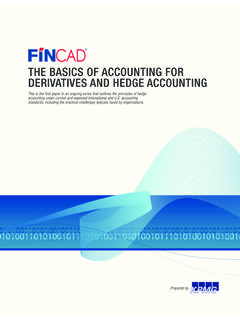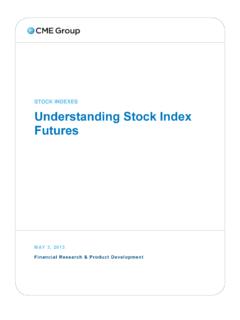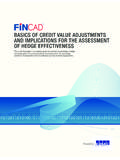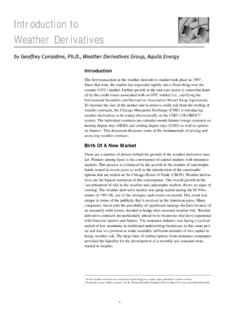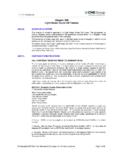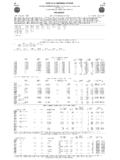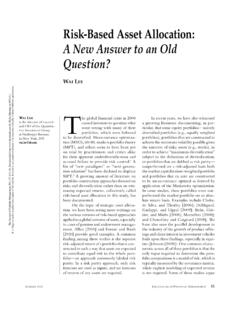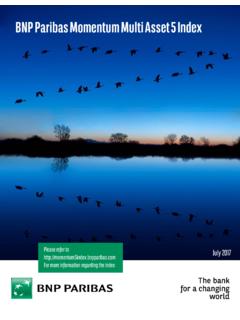Transcription of Understanding Risk Parity - cmegroup.com
1 Understanding Risk ParityThe Clifton Group A Division of Parametric Portfolio Associates, LLCA uthors: Thomas Lee, CFA Andrew Spellar Paul Bouchey, CFAThe most important decision any investor makes, ahead of manager or security selection, is a portfolio s asset allocation. A decade of challenging markets, particularly for equities, has led to growing investor interest around risk Parity . This article seeks to explain what risk Parity is and how it offers investors the potential to achieve superior risk adjusted returns relative to a portfolio with a traditional asset allocation. This article also identifies the key differentiators among the various risk Parity strategies, and addresses some common investor concerns about the strategy.
2 Risk Parity s theoretical underpinnings come from the same Modern Portfolio Theory (MPT) that underlies traditional portfolio asset allocation. If one believes that there is a consistent long-term relationship between risk and return, as represented in Figure 1, then the asset classes that fall along the securities market line (SML) are assumed to all have similar risk adjusted returns over time. The social object of skilled investment should be to defeat the dark forces of time and ignorance which envelope our future. John Maynard KeynesWhat is risk Parity ?In its simplest form, risk Parity seeks to balance the contribution to total portfolio risk from each asset class that composes a diversified portfolio.
3 A traditional 60% equity / 40% fixed income portfolio, which is the base of many investors portfolios, is not diversified. Approximately 90% of the risk in this traditional portfolio is concentrated in equities, due to the fact that historically equities have been three times more volatile than fixed income securities. Risk Parity seeks to avoid this concentration of risk through the construction of a more diverse, risk balanced 1: Securities Market LineBondsEquitiesSystematic RiskExpected ReturnFor illustrative purposes onlyRF1 Excess return is defined as the expected return above a cash one accepts the premise that the risk adjusted returns of all asset classes are equivalent, then a portfolio holding diversified asset classes that each contribute equally to risk should produce superior risk adjusted returns relative to a traditional 60/40 portfolio.
4 This point is defined in Figure 2 above as the Risk-Diversified portfolio. This portfolio depicts the maximum diversification benefit from holding the various diversified asset class exposures. However, it includes significant allocations to lower risk, lower expected return assets, like bonds. Consequently, this portfolio would not meet the return expectations of most long-term investors. These investors compensate for the expected return shortfall by gravitating up the efficient frontier towards portfolios that are comprised of higher allocations to riskier assets ( 60/40 portfolio). This move is executed with the expectation of achieving higher returns, however, the outcome is the surrender of diversification benefits.
5 100% Bonds100% EquitiesCapital Market LineExpected ReturnRiskBenefit of Risk diversification andEfficient Portfolio ConstructionRisk-DiversifiedPortfolioRis k-DiversifiedPortfolio Leveraged to 60/40 Risk Level60/40 PortfolioFor illustrative purposes other words, if the expected returns for equities and fixed income securities were adjusted according to their respective levels of risk, then the excess return1 expected from equities would equal the excess return expected from bonds. This theory holds true when the slope of the SML is constant. Economic theory supports this outcome to the extent that the SML represents the capital structure of a dynamic economy.
6 According to the theory, if any component of the capital structure were to become significantly more efficient at delivering returns than another, free market forces would respond and remove the the expected returns for equities and fixed income securities were adjusted according to their respective levels of risk, then the excess return expected from equities would equal the excess return expected from bonds. 2 Figure 2: Why Risk Parity ?1 Excess return is defined as the expected return above a cash Parity is designed to help investors maintain a portfolio with significant risk diversification benefits while still meeting their return expectations.
7 This result is achieved through the prudent use of leverage. Specifically, leverage is employed within the Risk-Diversified portfolio to move it further up the capital market line to the point where it becomes risk equivalent to the 60/40 portfolio. The resulting levered Risk-Diversified portfolio has a higher expected return than the 60/40 portfolio with an equivalent amount of risk. Some have argued that if all asset classes can be adjusted to contribute the same total level of risk and therefore similar expected returns, then choosing between asset classes is no longer important. This is not the case.
8 If all asset classes had the same expected risk, then the selection of which asset classes to include in the portfolio should be driven solely by the asset class s diversification benefit. Put another way, if the question of expected return is removed from the portfolio construction process, then the focus is shifted to managing risk through portfolio diversification . A less discussed, yet important, advantage of a risk Parity approach is its potential to realize significant incremental returns through rebalancing. The amount of excess return generated through rebalancing is a function of asset class volatility and diversification .
9 All else equal, the more volatile and diversified the assets within a portfolio, the more value that can be created through rebalancing. In the risk Parity portfolio, assets are selected based on their diversification benefits and levered up or down to achieve target volatility. This construction process creates an ideal environment for systematically harvesting gains in the portfolio through is worth noting that a risk Parity strategy can target any level of portfolio risk and thus excess return. Theoretically, an investor with a relatively long time horizon would prefer to target a higher level of risk, while an investor with a shorter time horizon would be inclined to seek a lower level of risk.
10 Both investors would hold the same asset classes and thus own similarly diverse portfolios. The only difference between the portfolios would be notional exposure required to achieve the investor s target risk risk Parity strategies target a 10% level of realized risk. This is the level of risk historically exhibited by the traditional 60/40 portfolio. At this risk level, a risk Parity manager generally expects to generate 6% of annual excess return. Over the last 25 years, a traditional 60/40 portfolio has generated approximately 4% of annual excess return.. if the question of expected return is removed from the portfolio construction process, then the focus is shifted to managing risk through portfolio A risk Parity strategy can target any level of portfolio risk and thus excess a portfolio based on risk and diversification benefits requires measuring an asset class s risk and its correlation to other asset classes.
